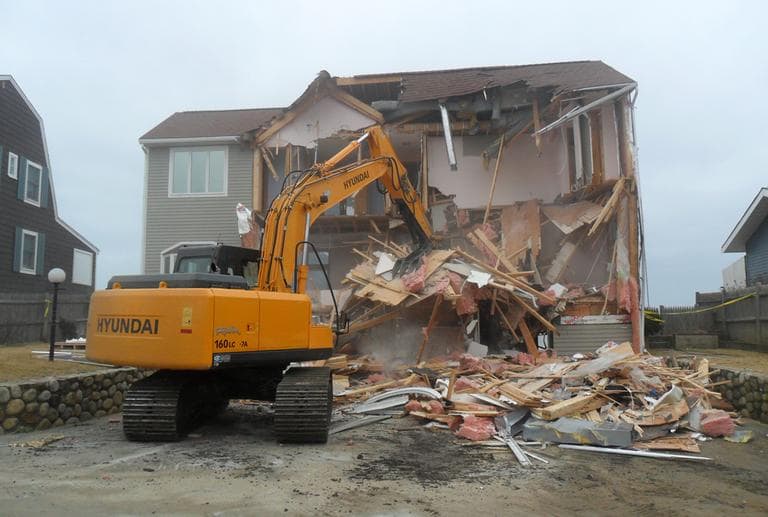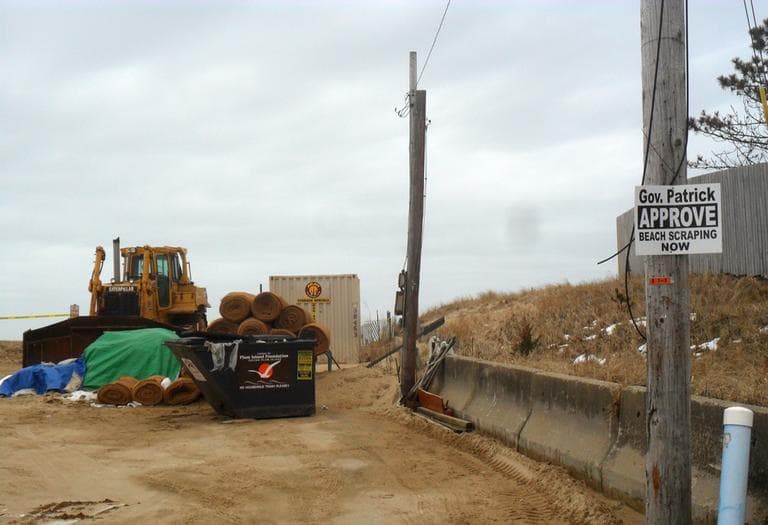Advertisement
Plum Island Residents Scramble To Save Homes As Beach Erodes

With as many as 40 homes on Plum Island in danger of falling into the sea after a series of devastating storms, Massachusetts officials say federal emergency funds may be available to help homeowners save their houses.
Plum Island's History
Over the 5,000 years since Plum Island was formed, winds and the Atlantic Ocean have sculpt the spit of sand into an 11-mile long, half-mile-wide barrier island.
"The barrier island is a dynamic system, it changes," said Frank Drauszewski, deputy refuge manager with the Parker River National Wildlife Refuge, which protects most of the island. "Its function is to change. The sand shifts, the sand moves. Certain times it will erode, certain times it will accrete or build up. So it moves, it's shifting. But when people build houses on barrier islands they don't want it to change."

Plum Island — named for the marble-sized, wild plums that grow in the fall along the beach -- has always been a haven for migratory birds and wildlife, but about 60 years ago people began building modest seasonal houses on the north end, usually 100 yards or more from the ocean. Then came paved streets, sewers and homes built right along the coastline with million-dollar views and price tags to match.
Since December, three major storms have ripped through here, and the last one sent two homes falling into the ocean and left another 40 at risk.
"My heart goes out to the people who have houses on Plum Island," Drauszewski said. "You think they have life investment out here and they're at the whim of the ocean, at the whim of nature. I feel really bad the houses fell into the ocean, but you think about building a house on a pile of sand with the ocean next door and it's probably not a long-term situation you want to get into."
Drauszewski says the last storm was the worst he's seen in his 21 years on the island.
Advertisement
"Up here to the north is where all the damage took place to the homes," Drauszewski explained. "You can see the heavy equipment on the beach there. And they're actually in the process of removing all the debris of all the houses that toppled over."
Thirteen homes on Plum Island have been declared unsafe by inspectors and the owners have lost their occupancy permits.
What About Sand Scraping?

Plum Island resident Greg Sawyer, who owns a house up the street from where the worst damage is, says the state should permit sand scraping — a practice residents say can help save their homes, but officials say isn't helping.
"The [Department of Environmental Protection] regulations wouldn't let us protect our homes against the storm surge and now these houses are lost," Sawyer said. "We would have put rocks and boulders and whatever on the beach instead of leaving it to the ocean. Or we would have pushed up sand as we've done many many times before."
In the aftermath of the storm, the head of Massachusetts Department of Environmental Protection decided not to enforce rules that had prevented homeowners from moving sand to the beach in an attempt to save homes teetering on what's left of the shore.
Ken Kimmell, the DEP commissioner, says there are better ways to help save the homes.
"Eight homes did that beach scrapping. Two have been destroyed, two have lost their occupancy permits," Kimmell said. "The homes that did much better are the ones that have taken the time and effort to be jacked up and put on pilings or moved off the dune. We continue to believe the only way to protect those homes is to get them out of harms way."
A sign in the center of Plum Island, near the public beach, asks Massachusetts Gov. Deval Patrick to permit beach scraping.

Jim Spaziano's house is set four streets back from the ocean and only suffered minor damage in the recent storm.
"Just a couple of flaps off the roof, but no, we've been lucky and we've been through a number of storms over the years and it's just a barrier beach, it's all sand and it's very difficult to protect anything from it when you're right on the beach," Spaziano said.
Kimmell says the real problem is the rate at which the shoreline is receding.
"It took about 100 years to lose its first 100 feet," Kimmell explained. "It's lost its second hundred feet since 1994."
The ocean is relentless, and the United Nations says as the planet warms and ice caps melt this is just one more sign of what's ahead.
"I believe the future is now," Drauszewski, with the Parker River refuge, said. "People keep talking about climate change, people talk about sea level rise. I mean we're witnessing it right now with the frequency of the storms, the intensity of storms, the erosion we're seeing on this barrier island. As I said, the future is now."
This program aired on March 15, 2013.
